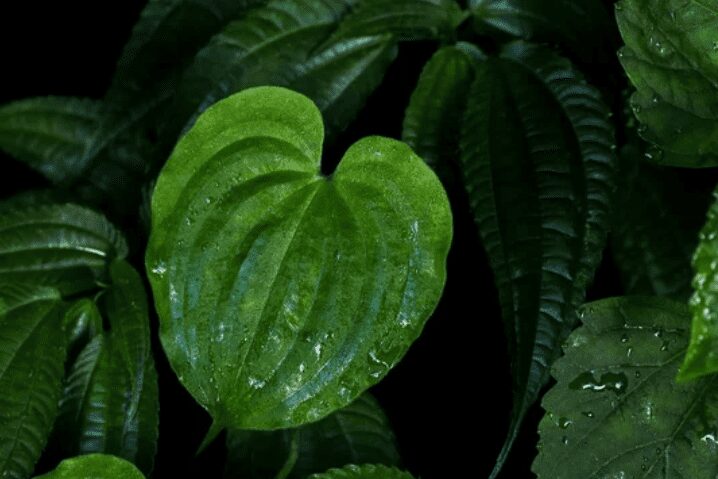
Looking to add a touch of greenery to your home or office? Why not opt for plants with heart shaped leaves? Not only do these plants bring decorative charm to any space, but they also offer a range of benefits. As we explore the advantages of heart-shaped leaves, we will examine the fundamental concepts behind them.
From adding a focal point in a room to improving air quality and providing stress relief, these plants are a must-have for any plant lover. We will also share our top 6 picks for the best plants with heart-shaped leaves indoors and outdoors. Get ready to fall in love with these leafy beauties!
Ferns are a popular choice for those looking for plants with heart shaped leaves. Heart ferns have a unique and remarkable appearance, with leaves resembling arrowheads and hearts. They also have attractive wire-like stems that add to their aesthetic appeal.
Heart ferns thrive in moist and humid conditions, but it’s important not to overwater them as they can suffer from root rot. Overall, ferns make a beautiful addition to any indoor or outdoor garden.
Plants with Heart-Shaped Leaves
Heart-shaped leaves are a charming characteristic found in many plants. These leaves typically have a rounded base with a gentle point at the tip, resembling the classic heart shape.
Plants like the Hoya, Philodendron scandens, Anthurium, Oxalis triangularis (purple shamrock), Ceropegia woodii (String of Hearts), Caladium, Cyclamen, and Pilea peperomioides.
Sweet Potato Vine and Cyclamen are popular houseplants with heart-shaped leaves, making them a popular choice for indoor gardening enthusiasts.
Outdoor Plants with Heart-Shaped Leaves
There are several plants that not only have heart-shaped leaves but thrive outdoors. I know redbud trees for their heart-shaped foliage and pink blossoms. Another plant with heart shaped leaves perfect for outdoor growing is the Morning Glory, which has beautiful trumpet-shaped flowers and fast-growing vines.
Edible Heart-Shaped Leaves
Certain plants with heart shaped leaves are not just aesthetically pleasing but also edible. Nasturtiums are popular garden plants with vibrant flowers, and heart shaped leaves that are both edible and have a peppery taste. Another plant with edible heart-shaped leaves is the Common Sorrel, which has a tangy flavor ideal for soups and salads.
Benefits of Having Plants with Heart shaped Leaves
Heart shaped leaves on plants offer many benefits, making them an excellent choice for indoor or outdoor spaces. These foliage beauties, such as the Hoya, Anthurium, and Heartleaf philodendron, not only add a touch of romance and beauty to your surroundings but also have air-purifying properties, improving the overall air quality in your home.
Their low-maintenance nature and ability to thrive in various lighting conditions make them perfect for beginners or busy individuals. The heart-shaped leaves symbolize love and compassion, creating a calming and soothing atmosphere, perfect for unwinding after a long day.
Adding these plants to your home or office can enhance aesthetic appeal, increase productivity, reduce stress, and improve overall well-being. So, why not fill your space with these lovely green companions that offer visual delight and emotional well-being?
Decorative touch to any home or office
Plants with heart shaped leaves offer a decorative touch to any home or office space, effortlessly adding beauty and elegance. The Philodendron scandens, Hoya kerrii, and Anthurium andraeanum are just a few examples of these stunning houseplants.
Their heart shaped foliage symbolizes love and affection, making them an excellent gift choice, particularly on occasions like Valentine’s Day. You can showcase these plants in hanging baskets or display them on tabletops as they thrive in various lighting conditions, from bright and indirect to low light.
Their low-maintenance nature makes them perfect for busy individuals or beginners in plant care. Embrace the beauty of heart-shaped leaves and infuse your space with warmth and tranquility.
Focal point in a room
Plants boasting heart-shaped leaves effortlessly become a captivating focal point in any room. Their unique foliage adds whimsy and charm, instantly grabbing attention. Symbolizing love and affection, these plants are perfect for creating a romantic or intimate ambiance.
They infuse spaces with a touch of nature and vibrant greenery, breathing life into any room. Consider incorporating eye-catching varieties like philodendrons or pothos, which feature large, heart-shaped leaves for a stunning focal point.
Variety in sizes, shapes, and colors
Plants with heart shaped leaves come in various sizes, shapes, and colors, offering endless options for your indoor or outdoor space. From delicate hearts to bold foliage, these plants provide a range of choices. With philodendrons, hoyas, and strings of hearts, you can find the perfect one to enhance your existing decor.
These plants offer more than just foliage. The sweetheart hoya, for example, blooms with charming purple flowers, while the cyclamen boasts lovely red leaves. Whether you prefer vines, succulents, or lush houseplants, there’s a heart shaped plant to suit your tastes. Bring love and beauty to your surroundings with these stunning plants.
Easy to care for and low maintenance
Plants with heart shaped leaves make a great addition to any home or office. These low-maintenance houseplants are easy to care for and can thrive in various indoor environments. With their unique foliage and charming heart-shaped leaves, they add a touch of whimsy and beauty to any space. Whether placed in a hanging basket or displayed on a shelf, these plants serve as a decorative element.
Wide varieties, such as the Philodendron or String of Hearts, are suitable for beginners or individuals with busy lifestyles as they can withstand neglect. Bring some greenery into your home with these easy-care plants, perfect for adding a touch of nature and freshness to your space.
Improving air quality
Philodendrons and pothos are plants with heart shaped leaves famous for purifying indoor air. These plants effectively filter out toxins like formaldehyde and benzene, creating a healthier environment. Heart-shaped leaf plants release oxygen and increase humidity, which can help reduce respiratory issues and improve overall well-being.
Besides their air-purifying qualities, these plants add a touch of natural beauty and greenery to any space. Caring for plants with heart shaped leaves is relatively easy, as they usually require moderate watering and indirect sunlight. With their ability to improve air quality and low maintenance needs, plants with heart-shaped leaves are an excellent choice for beginner gardeners and those with busy lifestyles.
Stress relief benefits
Plants with heart-= shaped leaves offer more than just aesthetic appeal. These green beauties, such as the hoya kerrii or heart leaf philodendron, add a touch of whimsy and visual interest to any space. Research has shown that being around plants can reduce stress levels and promote a sense of calm. The unique shape of their foliage enhances the stress-relieving benefits.
Green has a soothing effect on the mind and body, making heart-shaped leaf plants even more beneficial for stress relief. Taking care of these plants and watching them thrive can provide a sense of accomplishment and purpose, reducing stress.
Whether in an office, home, or outdoor environment, incorporating plants with heart shaped leaves, like the sweetheart hoya or philodendron gloriosum, can help create a serene and relaxing atmosphere.
Eight best plants with heart shaped leaves for indoors and outdoors
Plants with heart shaped leaves bring beauty and charm to any indoor or outdoor space. From the delightful Hoya Kerrii, also known as the Sweetheart Plant, to the vibrant Anthurium Andraeanum with its glossy foliage and stunning blooms, there are many options to choose from.
If you’re searching for a trailing plant, the String of Hearts (Ceropegia Woodii) is an excellent choice, with its delicate vines cascading down. Consider the Monstera Adansonii, featuring unique perforated heart-shaped leaves for a tropical touch. These plants thrive in indirect light, adding a touch of whimsy and visual interest to any setting, especially as indoor plants with heart shaped leaves.
Swiss Cheese Plant [Monstera Deliciosa]
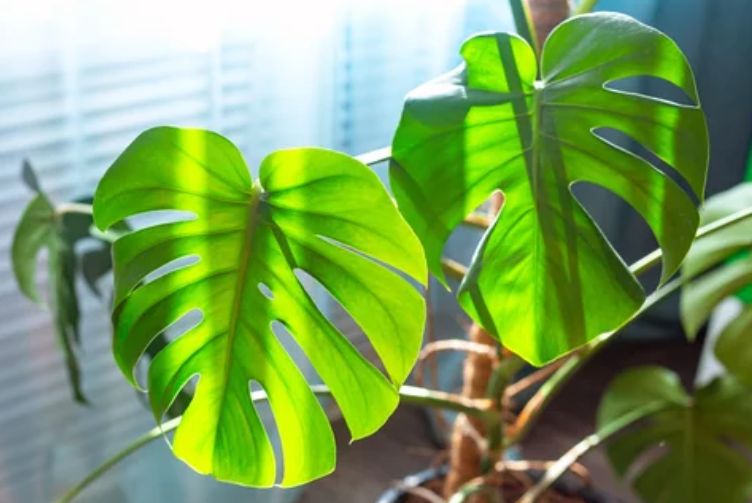
This trendy plant has large, glossy leaves with unique splits and holes resembling Swiss cheese.
-
Care: The iconic Swiss Cheese Plant enjoys bright, indirect light. Allow the top few inches of soil to dry out between waterings. Thriving in humidity, regular misting or grouping with other plants will keep it happy. A well-draining potting mix with added chunky materials like bark or perlite is ideal. As it grows, provide it with a moss pole or trellis for support.
-
Interesting Facts: Those signature splits and holes, called fenestrations, are thought to help Monstera deliciosa withstand heavy rain and wind in its native rainforest environment. In ideal conditions, this plant can reach impressive sizes, with leaves spanning a few feet wide! Mature Monstera deliciosa will sometimes produce an edible fruit resembling a mix of corn and pineapple in flavor.
-
Varieties: While the classic green Monstera deliciosa is stunning, explore these beautiful variations:
- ‘Thai Constellation’: Features creamy white variegation splashed across its leaves, creating a starry night effect.
- Monstera adansonii: Sometimes called the “Swiss Cheese Vine”, this smaller variety boasts similar fenestrations on a more petite scale.
- ‘Albo Variegata’: One of the most sought-after varieties, prized for its dramatic marbled white and green foliage.
Additional Tips
- Cleaning Leaves: Gently dust the large leaves of your Swiss Cheese Plant regularly to maintain its glossy appearance and help with photosynthesis.
- Aerial Roots: Don’t be afraid of those wild aerial roots! Guiding them into the soil can provide extra nutrients for your plant.
Heart Leaf Philodendron [Philodendron Scandens]

This classic vining plant is a favorite for its easy care and glossy heart-shaped leaves.
-
Care: As one of the most adaptable houseplants, the Heart Leaf Philodendron thrives in various lighting conditions, from bright indirect light to lower light areas. Allow the soil to dry slightly between waterings, as overwatering is one of the few ways to harm this resilient plant. A standard, well-draining houseplant potting mix works perfectly.
-
Interesting Facts: Philodendron scandens is often used interchangeably with Philodendron hederaceum, but they are technically separate species. Both are beloved for their heart-shaped foliage and easygoing nature. In its natural tropical habitat, the Heart Leaf Philodendron climbs trees using its aerial roots, with its leaves growing larger as it reaches toward the sunlight.
-
Varieties & Versatility:
- ‘Brasil’: Features variegated leaves splashed with lime green and yellow, adding a vibrant touch.
- ‘Lemon Lime’: Boasts bright, chartreuse foliage that brightens any space.
- Philodendron scandens ‘Micans’: Offers a unique look with velvety heart-shaped leaves in rich shades of bronze, green, and pink.
- The Heart Leaf Philodendron’s vining growth habit makes it perfect for hanging baskets, trailing from shelves, or climbing a support structure like a moss pole.
Additional Notes:
- Easy to Propagate: Heart Leaf Philodendrons are incredibly easy to propagate by stem cuttings, making them a great plant to share with friends or expand your own collection.
- Non-Toxic to Pets (Usually): While Heart Leaf Philodendrons are generally considered non-toxic to cats and dogs, they contain calcium oxalate crystals which can cause mild irritation if ingested. It’s best to keep them out of reach of curious pets.
The String of Hearts [Ceropegia woodii]

This charming succulent has delicate heart-shaped leaves that cascade on thin, trailing vines.
-
Care: This unique succulent vine appreciates bright, indirect light. Let the soil dry out ultimately between waterings, as String of Hearts is sensitive to overwatering. A well-draining succulent or cactus mix is ideal. Due to its shallow roots, smaller pots are often preferred.
-
Interesting Facts: String of Hearts develops small potato-like tubers along its stems, storing water and aiding in propagation. Its delicate pink and purple blooms resemble tiny lanterns, adding charm. In its native South Africa, the tubers are an occasional food source for local people.
-
Display & Versatility:
- The trailing vines of String of Hearts look stunning spilling from hanging baskets or cascading down shelves.
- Consider training the vines to climb a small trellis or hoop for a unique, heart-filled display.
- Get creative with pot choices – shallow terracotta pots complement its delicate appearance beautifully.
Additional Notes
-
Propagation: String of Hearts is delightfully easy to propagate. Methods include:
- Layering tubers on top of soil in a new pot.
- Pinning sections of the vine to the soil to encourage rooting.
- Traditional stem cuttings are rooted in water or soil.
-
Nicknames: The String of Hearts has many endearing names, including Rosary Vine, Chain of Hearts, and Sweetheart Vine.
Sweetheart Hoya [Hoya Kerrii]

This adorable succulent has thick, fleshy, heart-shaped leaves, making it a famous Valentine’s Day gift.
-
Care: The Sweetheart Hoya is incredibly tolerant of neglect, perfect for less experienced plant owners. It prefers bright, indirect light and requires watering only when the soil is arid. A chunky, well-draining succulent or cactus mix is essential to prevent root rot.
-
Interesting Facts: Sweetheart Hoyas are often sold as a single heart-shaped leaf in a pot. While these can survive for years, they may not grow new vines without a node (a growth point on the stem). Hoya kerrii produces clusters of star-shaped, waxy flowers with a sweet fragrance, especially at night.
-
Varieties & Growth:
- Hoya kerrii ‘Variegata’: Features splashes or large sections of creamy white or yellow on its leaves, adding visual interest.
- While a single-leaf Sweetheart Hoya may remain that way, if you’re lucky enough to find one with a node, it has the potential to develop into a beautiful vining plant with multiple heart-shaped leaves.
Additional Notes:
- Patience: Sweetheart Hoyas are slow growers, so don’t be discouraged if you don’t see new growth immediately. With proper care, they can be long-lived, charming companions.
- Symbolism: Due to their resilient nature and heart-shaped leaves, Sweetheart Hoyas are often associated with love, patience, and enduring affection.
Velvet Philodendron [Philodenron Gloriosum]
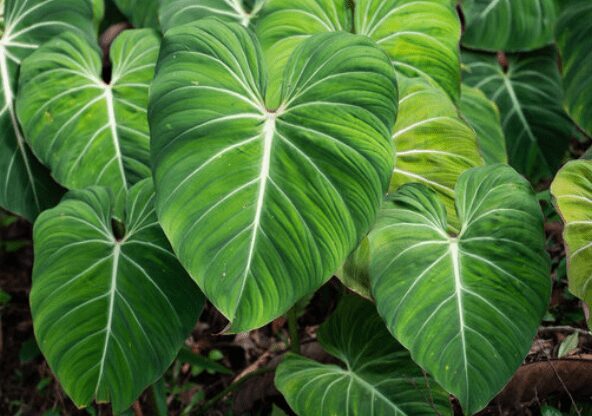
This stunning plant has large, velvety, heart-shaped leaves with contrasting white veins.
-
Care: Velvet Philodendrons enjoy bright, indirect light but will tolerate some lower light levels. Maintain evenly moist soil, but avoid allowing it to become soggy. They thrive in a humid environment, so frequent misting, a pebble tray, or a humidifier are beneficial. A well-draining, slightly acidic potting mix with added orchid bark or perlite suits them well.
-
Interesting Facts: This captivating plant is a terrestrial crawler, growing along the rainforest floor instead of climbing like many Philodendrons. Their velvety leaves help capture moisture, and their prominent white veins aid light absorption in their low-light native habitat.
-
Mature Beauty: Young Velvet Philodendrons have smaller, more rounded leaves. As the plant matures, the leaves become dramatically larger, more deeply heart-shaped, and develop even more pronounced venation.
-
Collector’s Plant: Velvet Philodendrons are highly sought-after among houseplant enthusiasts due to their unique beauty and demanding care requirements.
Additional Considerations:
- Support: While it naturally crawls, providing a small stake or trellis can help guide the Velvet Philodendron’s growth more uprightly.
- Rarity: Due to its popularity and specific care needs, the Velvet Philodendron may be harder to find and more expensive than other common philodendrons.
Alocasia Silver Dragon [Alocasia baginda ‘Silver Dragon’]
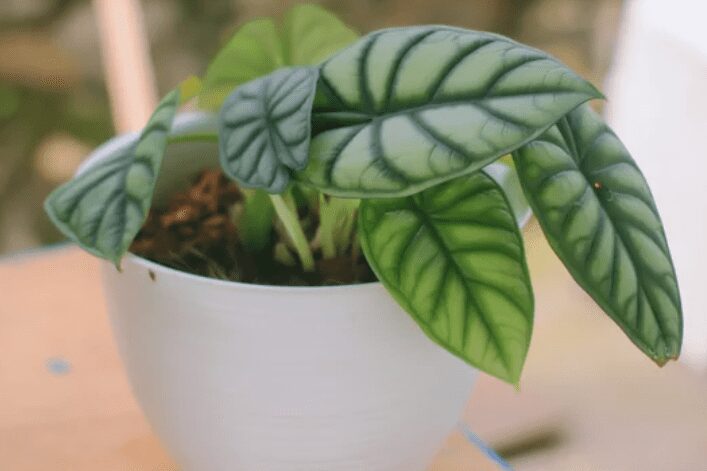
This striking plant features textured, silvery-green leaves with dark green veins resembling dragon scales.
-
Care: Alocasia Silver Dragon enjoys bright, indirect light. Allow the top inch or two of soil to dry out between waterings. Like most Alocasias, this plant thrives in higher humidity – misting frequently, using a pebble tray, or keeping it in a naturally humid space like a bathroom is beneficial. A loose, well-draining aroid potting mix is essential.
-
Interesting Facts: The Alocasia Silver Dragon’s unique scale-like leaf texture and silvery sheen give rise to its mythical name. This cultivar of Alocasia baginda is known for being slightly more forgiving than some other Alocasia varieties. Mature plants can occasionally produce dramatic, hooded inflorescences similar to calla lilies.
-
Dormancy: Alocasias can enter periods of dormancy, where they may lose some or all of their leaves. Don’t panic! Reduce watering during these times, and your plant should re-emerge with fresh growth when conditions are favorable.
-
Visual Impact: The Alocasia Silver Dragon’s dramatic foliage makes it a true statement piece. Please place it in a spot where its unique beauty can be appreciated.
Additional Notes:
- Toxicity: Like other Alocasias, the sap of the Silver Dragon contains calcium oxalate crystals, which can irritate pets and humans if ingested.
- Rarity: Alocasia Silver Dragons are often considered uncommon, adding to their allure for plant collectors.
Heartleaf Philodendron (Philodendron hederaceum)

This classic vining plant is a favorite for its easy care and glossy heart-shaped leaves.
- Care: Heartleaf Philodendrons are incredibly forgiving, making them popular for beginner plant enthusiasts. They thrive in medium to bright indirect light but tolerate low-light conditions. Water thoroughly when the top inch of soil feels dry. These plants enjoy a well-draining potting mix with added perlite or bark for aeration.
-
Interesting Facts: Heartleaf Philodendrons are known for their aerial roots that help them climb in their natural rainforest habitat. Their foliage can change with age, starting as simple hearts and developing lobes as they mature.
-
Varieties: Spice up your collection with different Heartleaf Philodendron cultivars:
- ‘Brasil’: Features variegated leaves with yellow and lime green streaks.
- ‘Micans’: Boasts velvety, heart-shaped leaves in deep green and bronze shades.
- ‘Neon’: Adds a pop of color with its chartreuse, almost glowing foliage.
Anthurium
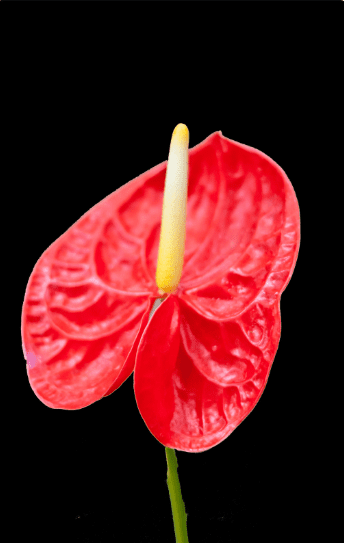
This tropical plant has large, glossy heart-shaped leaves and stunning, colorful flowers.
-
Care: Anthuriums prefer bright, indirect light and consistent moisture. Allow the soil to dry slightly between waterings, but avoid complete dryness. They thrive in humidity, so regular misting or a pebble tray is beneficial. Use a loose, well-draining potting mix specifically for epiphytes or orchids.
-
Interesting Facts: The colorful part of an Anthurium “flower” is a modified leaf called a spathe. The true flowers are tiny and clustered on the central spike (spadix). Anthuriums symbolize hospitality and are often given as gifts.
-
Varieties: While many Anthuriums have heart-shaped leaves, some popular choices include:
- Anthurium andraeanum: The classic “flamingo flower” with bright red, pink, or white spathes.
- Anthurium clarinervium: Features velvety, deep green leaves with contrasting white veins.
- Anthurium crystallinum: Prized for its large, heart-shaped leaves with sparkling, silvery veins.
Conclusion
In the fascinating world of horticulture, a heart-shaped leaf plant can be the perfect addition to your indoor or outdoor garden. Plants with heart-shaped leaves are trendy; they bring a touch of love and nature to your environment.
One of the crowd-pleasers is the Heart Leaf Philodendron, which has heart-shaped foliage and is an easy plant to care for. We can place the Heart Leaf Philodendron in hanging baskets, and it will thrive in indirect light, making it a lovely plant that adds a lush green touch to any space.
Another popular plant is the Swiss Cheese Plant. This trendy indoor plant has vibrant green leaves that are not entirely heart-shaped but have a unique pattern that resembles green hearts. This plant thrives in bright indirect light and well-draining soil, perfect for indoor settings. Place it near a south-facing window for optimum growth.
For something different, the String of Hearts, or Rosary Vine, is a trailing plant with perfectly heart-shaped green leaves. We often grow this succulent plant in hanging baskets and prefer bright, indirect sunlight. Its trailing stems can add an elegant touch to your home decor.
The Morning Glory plant is another favorite with heart-shaped leaves. This plant proliferates and produces beautiful purple flowers from late summer to early fall. People typically grow morning Glories outdoors and can reach several feet tall. This plant is a lovely addition to your garden, especially on trellises.
The Flamingo Flower, or Anthurium andraeanum, stands in contrast as it is famous for its heart-shaped flowers that usually come in red, and complement beautifully with its dark green leaves.. This tropical plant, native to Southeast Asia, prefers warm room temperatures and indirect sunlight.
The Sweetheart Hoya, or Hoya kerrii, is a must-have for Valentine’s Day enthusiasts. Its heart-shaped leaves resembling Valentine’s hearts make it a unique plant that’s easy to care for. It’s a succulent, so it doesn’t need much watering and can thrive in both indirect light and direct sunlight.
Heart Ferns are great plants for those looking for heart-shaped foliage with a rich dark green color. These plants are native to tropical regions and prefer part shade, indirect sunlight, and moist soil.
In conclusion, whether you opt for a Swiss Cheese Plant, Sweetheart Hoya, or the classic Heart Leaf Philodendron, including a heart-shaped plant with green leaves and heart-shaped foliage in your collection can be a fantastic way to add charm and elegance.
These plants are beautiful and symbolize the nurturing aspect of nature and our connection to it. So, get a plant with heart-shaped leaves, and let the green hearts flourish in your home or garden.


























